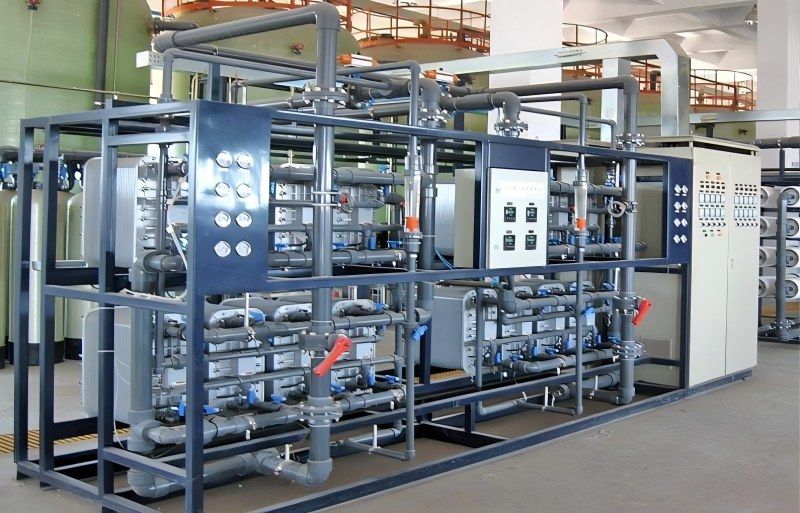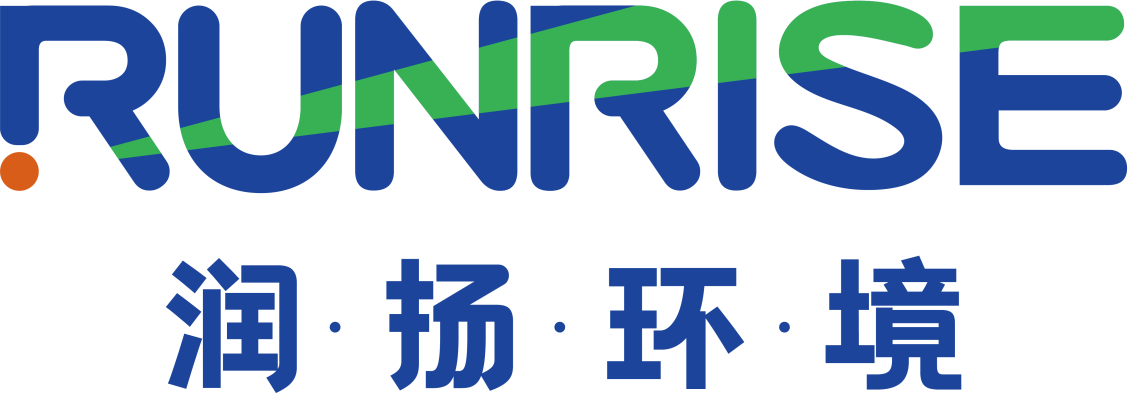Marketing Hotline:
(+86)0532-88988868
(+86)0532-88988868
1. Multi-media filtration
The main task of this stage is to roughly filter the tap water to prepare for entering the reverse osmosis membrane and ensure that the water quality reaches a certain level before entering the reverse osmosis membrane to protect the use effect and service life of the reverse osmosis membrane. The process is to filter the tap water of the original water tank through fine sand, activated carbon and precision filters to remove impurities, organic matter, colloids, suspended solids, etc. in the water, so as to prevent these large particles of impurities from entering the reverse osmosis membrane and blocking the reverse osmosis membrane. After rough filtration, the water quality has been improved to a certain extent. and allow to move on to the next link.
2. Primary reverse osmosis
In order to ensure the effect of reverse osmosis and protect the reverse osmosis membrane, it is necessary to continuously add scale inhibitors to the reverse osmosis vessel, and at the same time, the water temperature must be above 25 °C, (steam heat exchanger is used in winter) and a certain water pressure is ensured, (using a vertical pump) under a certain pressure, the ionized water is squeezed through the reverse osmosis membrane, Thus, two types of water are formed, and the water that passes through the reverse osmosis membrane is the finished water entering the next link, while the water that has not passed the reverse osmosis membrane is discharged, and the water that has undergone the primary reverse osmosis treatment enters the next link - secondary reverse osmosis.
3. Secondary reverse osmosis
The principle of secondary reverse osmosis is the same as that of primary reverse osmosis, and its function is to further remove the salt in the water, (Ca2, Mg2, Fe2-, SO42-, Cl-, Na and other ions) to further improve the water quality, and the conductivity of the water quality can be close to 1 MΩ·cm after secondary reverse osmosis. After the first and second stage reverse osmosis pretreatment, the last retained water becomes the feed water of EDI, while the water (concentrated water) that has not passed through the reverse osmosis membrane is discharged in time, and its ratio is generally 1:3, that is, for every ton of qualified water produced, about 3 tons of concentrated water (reclaimed water) must be discharged.
4. EDI (Electro deionization) processing
The water after secondary reverse osmosis is stored in the intermediate tank, and more than 99% of its ions have been removed, but in order to further improve the water quality and produce ultrapure water, the trace elements and CO2 dissolved in the water must also go through electrodialysis, that is, EDI treatment, the principle is as follows, EDI is continuous electrodesalination, which is the process of using mixed ion exchange resin to adsorb the anion and cation in the water, and these adsorbed ions are removed through the anion and cation exchange membrane under the action of DC voltage. In this process, the ion exchange resin is continuously regenerated by electricity, so it does not need to be regenerated using acids and bases. This technology can replace conventional ion exchange devices and produce ultrapure water with a resistivity of up to 18 MΩ·cm. This process technology is said to be a revolution in the water treatment industry. Compared with traditional ion exchange, EDI has the following advantages: EDI does not require chemical regeneration; EDI regeneration does not require downtime; Provide consistent water quality; low energy consumption; Easy to operate, low labor intensity; Low operating costs.

(1) EDI feed water treatment
Feed water pretreatment is important for EDI and its importance, the life, performance and maintenance amount of the module depend on the impurity content in the feed water, if EDI is provided with better pretreatment water, the cleaning rate of the module will be reduced. A part of the EDI concentrated water is circulated (when the hardness of the feed water is low and the conductivity is low, it can not be circulated), and the other part can be returned to the reverse osmosis feedwater, or it can be recycled for other uses or discharged directly into the sewer.
(2) EDI component structure
a. Freshwater chamber: Fill the ion exchange resin between the anion and cation exchange membranes to form a freshwater unit.
b. Concentrated water chamber: Each EDI unit is separated by a mesh to form a concentrated water chamber.
c. Pole water room.
d. Insulation board and compression plate.
e. Power supply and waterway connection.
EDI can be run in parallel to obtain greater flow rates.
(3) EDI process
Generally, there are solubilities such as sodium, calcium, magnesium, chloride, nitrate, and bicarbonate in urban water sources. These compounds are composed of negatively charged anions and positively charged cations. With reverse osmosis pretreatment, more than 99% of ions can be removed. In addition, the raw water may also contain other trace elements, dissolved gases (such as CO2) and some weak electrolytes (such as boron, silica) which must be removed in industrial desalination. However, the reverse osmosis process is less effective in removing these impurities.
The diagram above shows the working process of EDI, where ion exchange membranes are represented by vertical lines and indicate the types of ions they are allowed to pass through. These ion exchange membranes do not allow water to pass through. Therefore, they can isolate fresh and dense water currents.
Ion exchange membranes and ion exchange resins work similarly and can migrate specific ions. The anion exchange membrane only allows anions to pass through, but not cations. Cation exchange membranes are the opposite. Filling a pair of anion exchange membranes with mixed ion exchange resin forms an EDI unit. The space between the anion and cation exchange membranes occupied by mixed ion exchange resins is called the freshwater chamber. A certain number of EDI units are arranged together, so that the anion exchange membrane and the cation exchange membrane are arranged alternately, and each EDI unit is separated by a mesh to form a concentrated water chamber. Under the impetus of a given DC voltage, in the freshwater chamber, the anion and cation in the ion exchange resin migrate to the positive and negative electrodes under the action of the electric field, and enter the concentrated water chamber through the anion and cation exchange resin. In fact, the migration and adsorption of ions occur simultaneously and continuously. Through this process, the ions in the feed water pass through the ion exchange membrane and enter the concentrated water chamber to be removed and become desalination.
Negatively charged anions (e.g., 0H-, Cl-) are attracted by the positive electrode ( ) and enter the adjacent concentrated water chamber through the anion exchange membrane. After that, these ions continue to migrate to the positive electrode and encounter the adjacent cation exchange membrane, which does not allow them to pass through, and these ions are blocked in concentrated water, where the ions of the cathodic and cathode membrane are maintained through the ions of the cathode membrane.
The amount of current in the EDI module is directly proportional to the amount of ion mobility. The current is composed of two parts, one from the migration of the removed ions, and the other from the H and 0H- produced by the ionization of the water itself, which are continuously regenerated by the ion exchange resin.
The ion exchange resin in EDI components can be divided into two parts, one part is called the working resin, the other part is called the polishing resin, and the boundary between the two is called the working front. The working resin mainly plays a conductive role, while the polishing resin is constantly exchanged and continuously regenerated. Working resins are responsible for removing most of the ions, while polishing resins are responsible for removing hard-to-remove ions such as weak electrolytes.
(4) EDI power supply
The DC power supply used should be air-conditioned within the operating voltage range and can provide the voltage required for regeneration. The power of the DC power supply should meet the requirements of EDI maximum current (6A). The ripple rate of DC power supply cannot exceed 30%. Excessive ripple rates can cause EDI components to be subjected to higher than apparent effective currents/voltages in an instant, causing damage to the components. When multiple EDI components share a DC power supply, each EDI voltage/current should be independently adjustable. Equipped with voltmeter and ammeter. At the same time, it shall be equipped with a current limiting device. To protect the EDI components, the power supply should be turned off when the flow of water flowing through the EDI components is below a certain point.
(5) The instrument used for EDI
a. Pressure gauge: measure the feed water pressure and outlet pressure of EDI pure water, concentrated water, polar water. Secondary reverse osmosis EDI water treatment
b. Flow meter: measure the flow rate of pure water outlet, concentrated water inlet, polar water inlet and concentrated water replenishment.
c. Conductivity meter: Measure the conductivity of EDI feed water and concentrated water inlet.
d. Resistivity meter: measure the resistivity of EDI pure water.
e. Flow switch: If the flow rate of pure water, concentrated water, and polar water flowing into the EDI component is too low, the flow switch will prompt the system to shut down.
5. Preservation and water supply of pure water
In order to ensure the water quality, the method of nitrogen sealing is generally adopted, that is, nitrogen is filled from the top of the pure water tank. After water supply, the liquid level solenoid valve cooperates with PLC, when the water level of the pure water tank is lower than the minimum water level, the PLC starts the water production program, and the whole system begins to make water until the water level of the pure water tank reaches the highest water level, and the system stops making water.
The characteristics of deionized water equipment for electroplating are stable water quality and relatively low cost. Deionized water equipment is a water treatment device that removes anions and cations in water through reverse osmosis, ion exchangers, EDI and other methods. Deionized water equipment has stable performance and is widely used in pharmaceutical, electronics, chemical, glass, coating, boiler, laboratory and other industries.
Process flow of deionized water equipment for electroplating
1. The ion exchange method is adopted, and the process is as follows
Raw water→ raw water pressurized pump→ sand filter→ activated carbon filter→ precision filter→ yang resin filter bed→ yin resin filter bed→ yin and yang resin mixed bed→ microporous filter→ water point
2. The reverse osmosis method is adopted, and the process is as follows
Raw water→ raw water pressurized pump→ sand filter→ activated carbon filter→ precision filter→ reverse osmosis→ pure water tank
3. The reverse osmosis and mixed bed method is adopted, and the process is as follows
Raw water→ raw water pressurized pump→ sand filter→ activated carbon filter→ precision filter→ reverse osmosis → pure water tank→ pressurized pump→ anionic mixing bed→ precision filter→ water point
Industrial applications and market demand for EDI deionized water equipment
In recent years, EDI deionization has become more and more important in various industrial fields, and many industrial systems have begun to use electric deionization as an upgrade technology for their water treatment systems, such as the power industry, pharmaceutical industry, microelectronics industry, electroplating and metal surface treatment, etc.
(1) Electric power industry
It is estimated that the operating cost of water treatment units in the power industry accounts for about 10% of the cost of electricity, and the use of electric deionization instead of ion exchange resin can reduce the cost per 1,000 gallons of water from $11 to $1.75.
(2) Pharmaceutical industry
Although medicinal water is characterized by not requiring a high degree of deionization, the electric deionization system has the characteristics of simultaneous desalting and control of microbial indicators, so many companies have adopted RO/EDI integrated systems. It is said that the performance of this type of system is stable, the whole process is continuously monitored by the computer, and the fully automatic operation is unattended.
(3) Electronics industry
The electronic industry has extremely high requirements for water quality, the resistivity of water should be stable more than 18 MΩ, and the EDI effluent is generally about 15-17 MΩ, so in the production process of electronic grade water is mostly used EDI polishing resin system, that is, after EDI is added ion exchange, although this project still requires ion exchange, but because EDI has removed most of the ions, the polishing resin almost does not need to be recycled, so the water treatment cost is still very low.
(4) Electroplating and metal surface treatment
Electrodeionized water equipment can be used for electroplating wastewater treatment, which can reuse water and recover heavy metal ions. Experimental installations for this type of system are already available in the United States.


